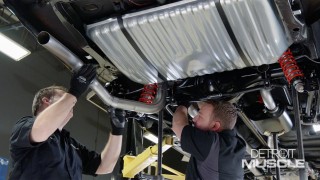How To Calculate Compression Ratio
We recently covered compression ratio and how it affects performance. Now we’re going to cover how to calculate it for your own power plant.
To determine compression ratio there are 5 volume measurements. To stay organized it’s helpful to list them on a sheet. Start with the cylinder volume at B.D.C. The bore is 125 and the stroke is 4″ so you can just plug those numbers into the equation for the volume of the cylinder:
.7854 x Bore² x stroke x 16.39 = 876.15 cl
This equation converts the results from cubic inches to cubic centiliters. We do this because the equipment is designed to measure in metric volumes.
The second measurement is combustion chamber volume. Most manufacturers will list this on their spec sheet but if there’s any doubt you can measure it yourself.
The third measurement is head gasket volume. The manufacturer will provide the bore and compressed thickness of the gasket and will use those numbers much like we did for measuring the cylinder volume:
.7854 x Gasket Bore² x Gasket x 16.39 = 9.08 cc
The fourth measurement is cylinder volume at T.D.C. and assumes measurement of a perfectly flat piston with no dome or dish:
.7854 x Gasket Bore² x Piston Depth x 16.39 = 1.10 cc
The final measurement is piston top volume. If it had a dome, it would take away volume and if it had valve reliefs it would add value. Since our application is completely flat, there’s no need for this measurement. If you do need to make this measurement, it’s the same way you would measure a combustion chamber.
With all 5 values known, add them together. This is the total volume at B.D.C (numerator). Then take the same number and subtract volume 1 from it. The result is the value at T.D.C (denominator). Divide those numbers and you have the compression ratio for your application.
Want to read more articles like this?
Join the PowerNation Email NewsletterRead More from PowerNation
Video Player is loading.
Current Time 0:00
/
Duration 0:00
Loaded: 0%
0:00
Stream Type LIVE
Remaining Time -0:00
1x
- Chapters
- descriptions off, selected
- captions off, selected
This is a modal window.









